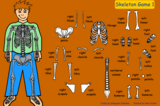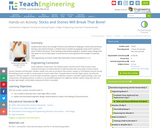
Students will use paper circuits to label various parts of the skeletal system.
- Subject:
- Biology
- Computer Science
- Engineering
- Healthful Living
- STEM
- Material Type:
- Activity/Lab
- Author:
- William Allred
- Carrie Robledo
- Date Added:
- 06/08/2021

Students will use paper circuits to label various parts of the skeletal system.

Students will understand and appreciate the work of their bones, muscles, and joints.This educator's guide provides a detailed lesson plan for instruction on the musculoskeletal system. The guide includes questions for discussion, outlines of two classroom activities, a quiz for assessment, and reproducible student handouts. In the first activity, "A Winning Combination," students write a play-by-play commentary describing how the parts of the knee joint work together to kick a soccer ball. In the second activity, "Dr. Build-a-Bone's Laboratory," students read an article about bones (including a cross-section diagram of a bone) to investigate what bones are composed of and how new bone is formed.

This printable and fillable worksheet assesses student knowledge about the bones that make up the human skeleton.

This resource provides a lesson plan over 2-3 class periods centered around the skeletal system in the human body. Students will participate in a variety of digital and non-digital activities to master content such as learning the basic functions of the skeletal system and naming the bones in the human body.

A 3rd-grade lesson plan implementing the 8 phases of explicit instruction for writing by Calderon and Slakk (2018): 1) Pre-teach the most important vocabulary; 2) Use a Mentor text for reading before writing; 3) Present the text structure to use; 4) Model it (Model each phase of the writing process); 5) Memorize it (Ensure that students memorize the language and steps of the strategy); 6) Support it (Scaffold according to student need); 7) Ample use of student interaction (Collaborate and cooperative writing strategies with other students); and 8) Differentiated assessment

In this interactive resource, students can learn about the bones making up the skeleton in the human body. Students will begin with a skeleton tutorial and then can play games where they will place the bones in the correct location of the body.

Students learn about the strength of bones and methods of helping to mend fractured bones. During a class demonstration, a chicken bone is broken by applying a load until it reaches a point of failure (fracture). Then, working as biomedical engineers, students teams design their own splint or cast to help repair a fractured bone, learning about the strength of materials used.